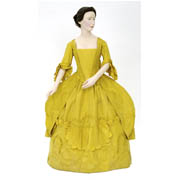Details
- Object type
dress; gown; robe
- Place Associated
Scotland, Perthshire, Perth (place associated); Scotland, Perthshire, Pitfour Castle (place associated)
- Date
circa 1760-1765 (dress)
- Materials
silk, linen, wool, hand-stitched
- Description
-
Woman's dress, sack back gown or robe à la Française (E.1986.62.5.a) and matching petticoat (E.1986.62.5.b) in yellow silk (18" wide). Dress with open bodice with pleated robings either side decorated with ruched, pinked-edged silk applied in serpentine vertical curving line. Elbow-length sleeves with box pleated, pinked-edged silk around cuff and double scalloped-edge flounces in increasingly length (cream machine-made lace frills added later removed during conservation in 2006). Back with sack back falling from two double box pleats from shoulders to hem. Skirt, open at front, constructed from full widths sewn selvedge to selvedge and gored panels of silk to go over panniers with pocket slits in side seams, decorated with ruched, pinked-edged silk robings attached in vertical serpentine curves either side with small sections. Three self-covered buttons, one centre back ankle, one each half-way up either side with silk cord loops on inside to loop skirts up slightly. Bodice and sleeves lined with linen, silk panel around hem of skirt. Petticoat, constructed from five full widths of silk sewn selvedge to selvedge and one pieced panel centre back, skirt pleated into waistband at centre front and back, fastening at sides with ties (later alteration, returned to original pleating during conservation in 2006), centre front decorated with folded silk applied curves, one large scalloped and pinked self-material furbelow in middle with ruched panels attached in intervals to stand proud either side, pinked ruched serpentine curved silk appliqué below ending with leaf-shaped motifs below furbelow. (Centre back panel later replaced in cotton, removed and replaced with wool during conservation in 2006). Lined with glazed wool or calamanco.
This sack-back gown or robe à la Française with matching petticoat was the height of fashion during the 1750s and 1760s. The curving Rococo patterns on the skirt and matching petticoat were very popular and can be seen in many portraits of society ladies by Allan Ramsay, Thomas Gainsborough and Sir Joshua Reynolds. The vibrant colour, sometimes called Chinese yellow, was probably dyed with weld, a natural plant dye. It was a particularly particularly fashionable colour for dresses in Britain during the 1760s.
Worn by Barbara Stuart, wife of John Richardson, the second son of Thomas Richardson and Beatrix Austin. He was couper initially in Perth, who later renounced that trade to become a highly successful salmon merchant. Not only was Mr Richardson able to dress his wife in the latest fashions, but also he purchased a country estate in Pitfour, Perthshire, in 1780 and commissioned Robert Adam to build Pitfour castle.
- Credit Line/Donor
Museum Purchase, 1986
- ID Number
E.1986.62.5
- Location
In storage
- Related People
Barbara Stuart owner, wearer







